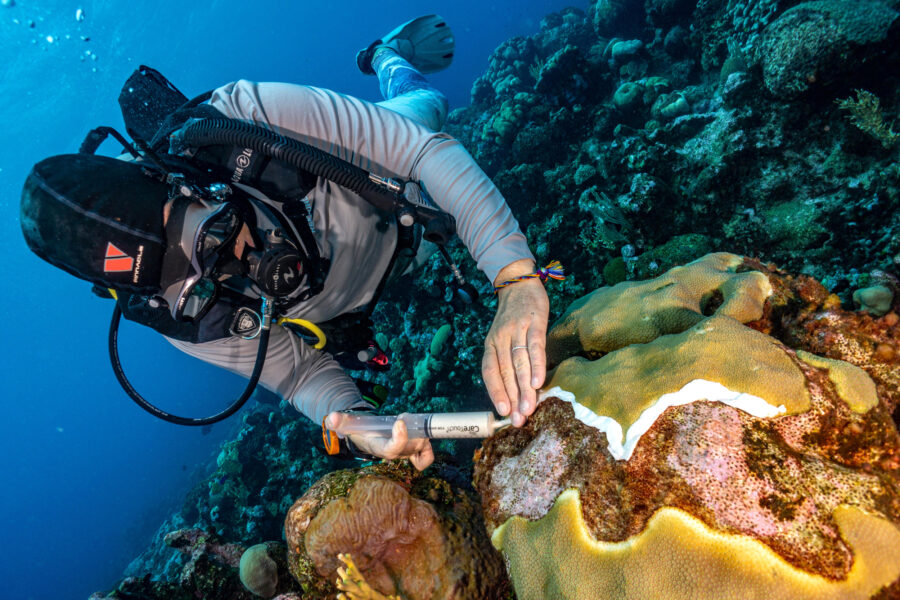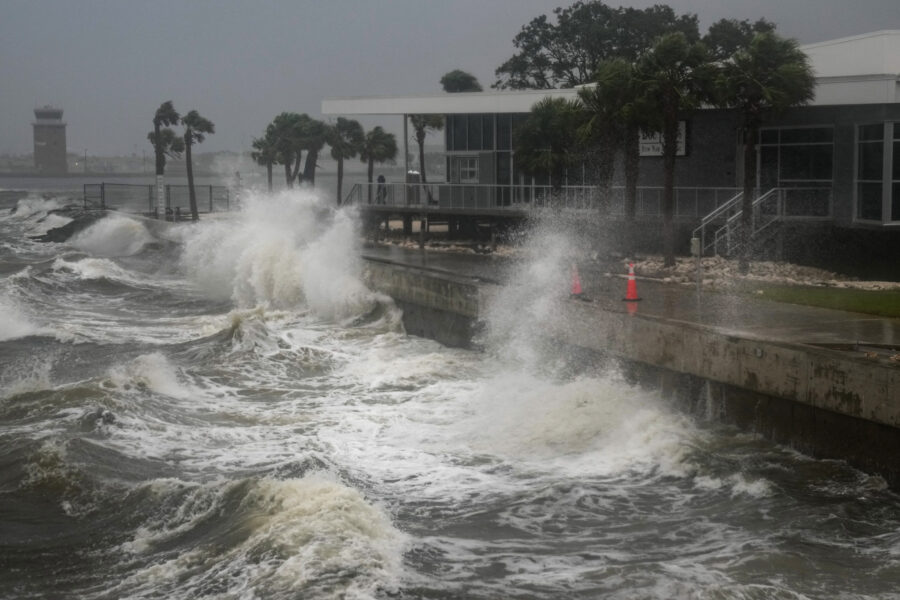Biobanking Corals: One Woman’s Mission To Save Coral Genetics in Turks and Caicos To Rebuild Reefs of the Future
PROVIDENCIALES, Turks and Caicos—On a recent Wednesday afternoon, a group of high school students studying marine science crowded inside a 540-square-foot office turned scientific lab set atop a police station at a popular marina. The students hovered over a sky blue fiberglass water tank as they prepared to watch a special group of corals eat.
It was feeding time at the Turks and Caicos Reef Fund coral lab and the animals could sense it.
“Did you give them their wake up call?” said Alizee Zimmermann, the organization’s executive director who built the lab after realizing corals were dying en masse in the ocean.
“Yes, I did,” her colleague, Gracie Perry-Garnette, responded.
Moments earlier, the coral aquarist had used a turkey baster to spurt tiny clouds of freeze dried phytoplankton and fishmeal into the tank to wet the animals’ appetite. Like Pavlov’s dog, their tentacles extended, eagerly reaching for more.

One by one, Perry-Garnette target fed each coral colony made of hundreds or thousands of individual animals called polyps, squirting the nutritious slurry closer to their mouths as Zimmermann and the students watched.
“Some of their mouths open up wide enough you can see into their stomachs,”she told the students as she fed a boulder brain coral, named after its meandering cerebral-like ridges. In between these ridges, tiny slits began to open wide within grass green colored valleys, exposing viewpaths to the animals’ gastric cavities as they ingested their meal.
Nearly 200 coral colonies are housed in this lab serving as a living biobank for some of the most vulnerable reef-building species at-risk of extinction due to climate change and disease in the Atlantic Ocean and the Caribbean. To keep them alive and preserve their genetic diversity, they will stay on land indefinitely, Zimmermann told the visiting students.
“It’s a Noah’s ark of the species,” she said. “We cannot put animals into a burning house.”
The Global Coral Reef Crisis
Record breaking ocean temperatures and disease are killing the world’s coral reefs, which provide food and habitat to a quarter of all marine life and support the livelihoods and wellbeing of an estimated 1 billion people, according to the World Resources Institute.
In the last 50 years, more than than ninety percent of the excess heat trapped by greenhouse gas emissions has been absorbed by the ocean, the National Oceanic and Atmospheric Administration (NOAA) reports. This has resulted in the upper ocean layers experiencing significant temperature increases, causing heat-related stress to many reef-building corals that grow in shallow tropical waters. Last year, NOAA’s 34th annual State of the Climate report said that the average global sea-surface temperature reached an all time high of 66.18 degrees Fahrenheit.
“The ocean temperatures got hotter and stayed hot for longer than any other time in recent history, or recorded history that we have,” said Zimmermann.
“It’s a Noah’s ark of the species. We cannot put animals into a burning house.”
— Alizee Zimmermann, Turks and Caicos Reef Fund executive director
Earlier this year, NOAA declared the fourth global coral bleaching event due to rising temperatures. Corals throughout the Atlantic, Pacific and Indian Ocean basins were so stressed they expelled the marine algae that lived in their tissue called zooxanthellae, which under healthy conditions provides the animals with food, energy and nutrients, as well as their color. Entire reefs turned ghostly white.
In some cases, bleached corals can recover if temperatures cool, but prolonged marine heatwaves like what they’ve been experiencing in the last year lessen their chances of survival. “If it goes on for too long, and they can’t re-recruit the algae, then that’s where we see the mortality,” said Jennifer Koss, director of NOAA’s Coral Reef Conservation Program.
Prior to the most recent mass bleaching, reefs had already been decimated along the Florida Reef Tract and throughout the Caribbean by a mysterious waterborne disease known as Stony Coral Tissue Loss Disease.
It was first detected off the coast of Miami in 2014 and has attacked more than 20 species of hard reef-building corals in nearly 30 countries or territories, eating away the animals’ live tissue and killing entire coral colonies within weeks, sometimes days.
Zimmermann was scuba diving when she first spotted signs of the disease near West Caicos, an island about 13 miles southwest of Providenciales. It was a moment that would change the course of her life.
Around the World and Back
As a child, Zimmermann learned how to swim before she could walk, she said. She was born in Turks and Caicos and raised by her French-Moroccan mother who moved to the islands from Miami in the 1970s for a job in the airline industry.
While at work, her mom would often leave her with a friend who would take her to swim regularly with a wild dolphin named Jojo that enjoyed socializing with humans. It was during these early childhood swims that she fell in love with the ocean. The feeling of weightlessness in the water was addictive and comforting.
Nearly 6 ft tall, Zimmermann, whose dark brown hair is cut in a chin-length bob, has always towered over many around her and felt an ease in the water she did not always feel on land. “I’ve always been very clumsy, and being in the water, being able to move in three dimensions and not feel that weight, is something that’s always been incredibly important to me, and incredibly powerful,” she said.
At twelve-years-old, she became certified to scuba dive and never tired of exploring coral reefs, which she said resembled “underwater cities” comprised of endless shapes, textures and colors. “Everywhere you look, there would be some kind of hidden critter just within, within all the crevices and depths.”
Explore the latest news about what’s at stake for the climate during this election season.
She never imagined she would one day be working to save these underwater ecosystems.
“I never knew that it was something you could study or make a job out of, which is why I’m so passionate about bringing marine science to students now,” she said. During her own years in school, she was naturally drawn to arts and humanities and pursued her bachelor’s and master’s degrees in literature at the University of Edinburgh.
From there, she continued traveling, eager to experience the world beyond her small island nation, landing in China, where she taught English as a second language, then Vietnam, where she became a scuba instructor, and finally the Netherlands, where she worked as a dog walker and illustrator.
After six years of being abroad, she returned home to Providenciales, the third largest island in the Turks and Caicos archipelago, a British territory located in the North Atlantic Ocean between the Bahamas and Dominican Republic. It was 2016 and a friend suggested that she volunteer with the Turks and Caicos Reef Fund.
The nonprofit had been founded in 2010 by Don Stark and David Stone, who had lived in the islands part-time for several years and wanted to help protect the environment through education, research and advocacy. They needed her scuba diving skills to help install mooring lines boats could tie up to instead of dropping anchor onto the reefs.
A Day That Would Change Her Life
The opportunity would eventually steer her to her calling.
In 2018, the reef fund paid for Zimmermann to get certified in conducting benthic surveys through the Atlantic and Gulf Rapid Reef Assessment (AGRAA) program, an international network of scientists, conservationists and others working to improve reefs throughout the Western Atlantic and Gulf of Mexico. It was her first professional marine science training.
She learned how to identify and monitor the health of non-swimming life forms on the seafloor, including algae, urchins, conchs and corals. It was that training, she said, that prepared her to detect when something was very wrong.
“May 23, 2019. This is the day that forever changed my life,” she remembered.
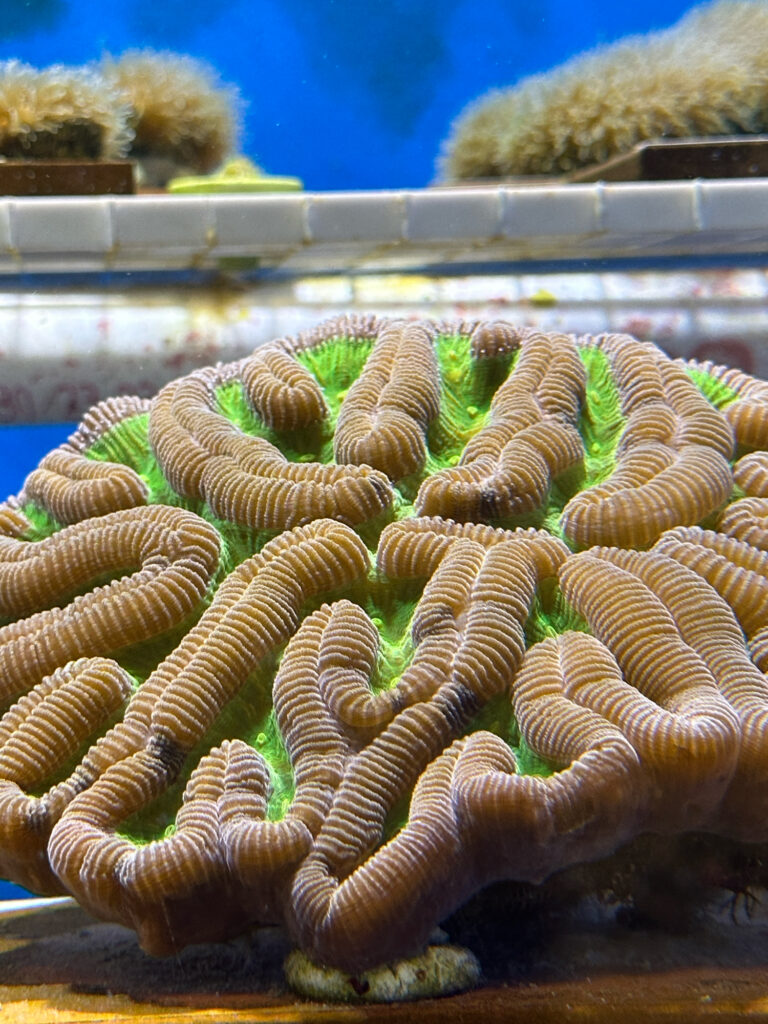
She was conducting a benthic survey near West Caicos when she saw a patch of reef where every coral looked like it was melting.“The skin, the flesh was peeling, just coming off and all you could see was bone.”
At first, she wasn’t sure what was causing the decay. She sent pictures of what she witnessed to Judith Lang, a marine biologist who helps coordinate coral restoration efforts throughout the Caribbean for AGRAA, who confirmed it was Stony Coral Tissue Loss Disease.
Over the next few months, Zimmermann continued to document the underwater catastrophe unfolding before her eyes nearly everyday with her underwater camera. On more than one occasion she had panic attacks underwater because of the devastation she was witnessing. “It was very distressing,” she said. “You’re faced with what looks like a forest after a forest fire.”
The once vibrant colorful reefs she had explored hundreds of times before were gray and silty. Turf algae had rapidly colonized the bare coral skeletons left behind after the disease devoured their tissues.
She began consulting with coral experts from Florida and the Caribbean about possible treatments. By Fall 2019, the reef fund hired her to work part-time as their Stony Coral Tissue Loss project manager.
She was sent to Key West, Florida to learn from scientists who had been trying to tackle the disease in their waters since the start. They didn’t know what caused it but believed bacteria played a role. They were treating some of the diseased corals’ infamous white lesions by applying amoxicillin packed into shea or cocoa butter. It wasn’t a cure-all, but it was saving some corals—or at least delaying their demise. She became hopeful by the prospect of being able to address the disease in some way and sought permission from the Turks and Caicos government to try the experimental treatments on its reefs.
Then, in 2021, she was hired as the reef fund’s executive director and began treating as many infected coral colonies as she could with the help of local volunteer scuba divers. They targeted the largest ones of reproductive size first, using a new hydrophobic paste developed by a company called Ocean Alchemist, which kept the antibiotic from leaching into the water. The goal was to keep the colonies alive, at least long enough for them to spawn, which only happens once or twice a year.
Zimmermann and her team spent hundreds of hours underwater treating at least 5,000 sick coral colonies, using syringes to apply the medicinal paste onto each colony’s lesions as if they were putting neosporin on cuts.
One of the corals she remembers treating was a 12-foot-tall pillar coral, likely hundreds of years old, which she has a photo of in the lab. She spent at least 40 hours treating this coral, willing it to live long enough to spawn a few more times. But after two and a half years of treatment it died. “We couldn’t keep up,” Zimmermann said. Even when she stopped individual lesions from spreading, others would pop up in different places, or on nearby corals.
She began thinking the only way to save the vulnerable corals would be to bring them ashore. “We need to take corals out of the ocean,” Zimmermann told Don Stark.“I said, ‘we have two years, and within two years, we need to be bringing corals into land, or we may lose this species.’”
She just wasn’t sure how. “The word ‘biobank’ didn’t even exist in my brain.”
An Unprecedented Coral Rescue
Before the disease outbreak, coral conservationists focused on using underwater nurseries to repopulate branching elkhorn and staghorn corals, which were nearly wiped out in the 1980s by another coral epidemic known as white band disease. Other scientists were using a technique called micro-fragmentation, which can help coral colonies grow more than 25 times faster than they would normally on a reef. The process involves bringing corals temporarily onto land and breaking them into smaller pieces—which stimulates their growth in a matter of months. As they grow, they begin to fuse together again. Corals’ ability to heal and regenerate themselves when their polyps are separated is one of their “superpowers,” Zimmermann said. Eventually, these fragments are then planted in coral nurseries, or on degraded reefs, with the intention of rebuilding them.
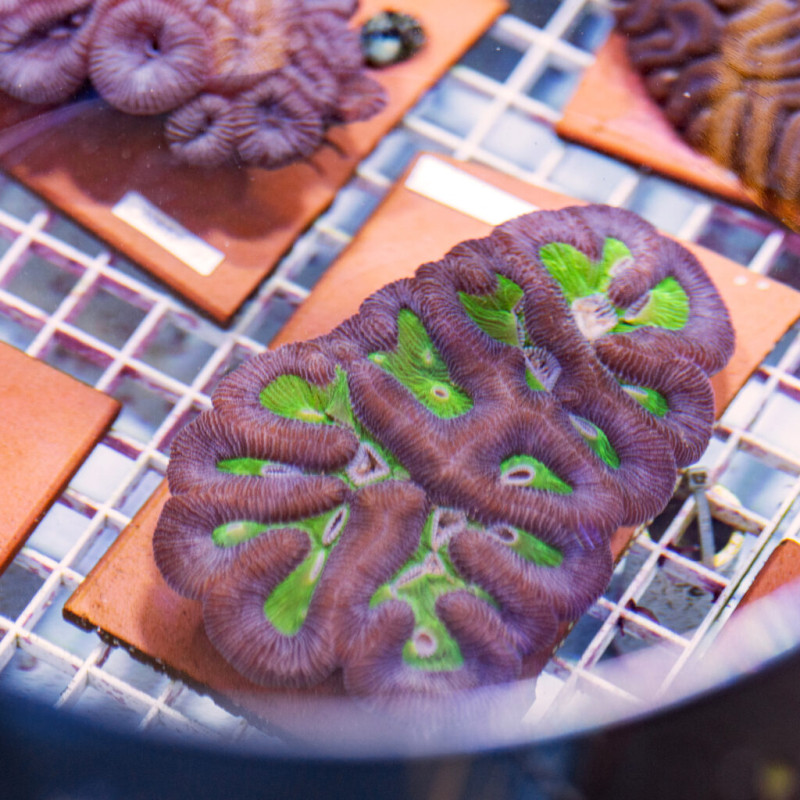
The idea of removing corals from the ocean permanently in order to preserve their genetics was something some scientists envisioned might occur as an extreme measure in the distant future, according to Lang, who has studied corals for more than thirty years. “I was imagining them in a decade,” she said. “The future came faster than we had expected.”
Scientists first removed corals from the water on a large scale to hold them in captivity for the long-term so they wouldn’t go extinct in 2018, in response to Stony Coral Tissue Loss Disease. The Florida Fish and Wildlife Conservation Commission and NOAA partnered with the Association of Zoos and Aquariums and other facilities to collect and hold some of Florida’s most vulnerable corals on land with the goal of propagating them in the future. It was the largest coral rescue effort in history.
A Biobank in Turks and Caicos
Zimmermann wanted to learn how she could do the same, albeit on a much smaller scale in Turks and Caicos. She applied for several grants to help her, but she was rejected. “Why would anyone fund somebody who’s never had a goldfish to do this?” she thought at the time.
But then the John Ellerman Foundation, based in London, which provides grants to charities advancing the wellbeing of people, society and the natural world, decided to give her a chance. Zimmermann’s hard won bona fides could no longer be denied.
“We got a grant to conduct a feasibility study as to whether people with no experience, on a small island, could keep coral alive out of the water,” she said.
As part of the proposed project, Zimmermann partnered with The Reef Institute, a coral reef restoration and research nonprofit based in West Palm Beach, Florida, that participated in the Florida Coral Rescue project. Currently, the institute holds more than 10,000 corals in its living biobank located in a 3,000-square-foot storefront office space where their staff are gene banking, spawning and raising Caribbean coral species.
The team there was eager to work with Zimmermann. They wanted to support small island nations in their reef restoration efforts and had presented the idea of biobanking to several groups from different countries. None were as eager at the time to take this on as Zimmermann was in Turks and Caicos, said Leneita Fix, executive director of The Reef Institute.
“We felt like if we pioneered this together and really showed her how to do this, then we could show how other groups in the Caribbean can do this,” she said.
In June 2022, staff from the institute visited Providenciales to evaluate the local organization’s office space and plan a biobank. They would need several shallow water tanks called raceways that look like open faced boxes on stands, special ultraviolet grow lights and a water filtration system. If the tanks were premade and purchased from the U.S., they would each cost at least $2,500, Zimmermann learned. That wasn’t in the small nonprofit’s budget. Plus, it would take at least six months for them to arrive on the island, and she was tired of waiting, she said.
She enlisted the help of a few friends and a local carpenter and together they made two raceways and a middle stand for an additional tank previously used to grow tilapia on a local, small-scale aquaculture farm. The entire setup cost less than $2,000 to build and was up and standing in two months. Then, it was time to collect corals.
“Corals of Opportunity”
The Turks and Caicos government had granted permission for Zimmermann to retrieve corals from the ocean, with the caveat that they should be “corals of opportunity,” she said. Whenever possible, she said, they wanted her to collect corals that likely would have been destroyed if they weren’t rescued from a coastal development project. She knew just the right ones.
A few months earlier, she’d gotten word that an old dock on the eastern end of Providenciales was slated to be ripped up for renovations. She’d heard there were corals growing on its underwater structure and went snorkeling to see for herself.
“It was incredible,” she said. There were fuzzy pillar corals, maze and elliptical star corals along with other hard coral species that were susceptible to disease. And they were growing upside down on the underside of the dock. Even the fish swam upside down around them. “It’s an upside down world,” she said. “There was more biodiversity on that dock than on our reefs at that time.”
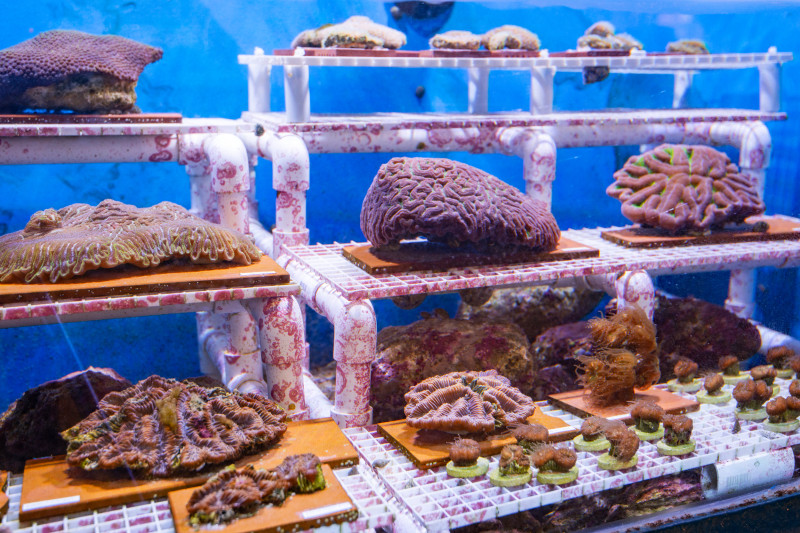
At least 60 percent of the islands’ live coral coverage had been lost since the disease outbreak in early 2019, according to the School for Field Studies in South Caicos.
Zimmermann recruited around 30 volunteers to help her rescue the animals, which would have otherwise been killed during the dock renovations. She divided them into two teams. Half of the people entered the water with snorkel gear and hammers and chisels they used to carefully break off live corals from the dock and place them in shopping baskets they kept underwater. When they were full, the snorkelers brought them to the surface and handed them over to other volunteers on deck who transported them on a boat to an old abandoned conch farm. The group rescued more than 400 corals.
When the raceways were built, Zimmermann brought around 50 of the rescued corals to live inside their new homes. Over the next few months, she worked closely with The Reef Institute team to learn how to monitor the corals and adjust to their needs. The animals require special lighting that mimics the sun’s intensity and color spectrum, which helps the algae living in the corals photosynthesize.
“We have to provide them with the light energy they need in order for them to grow and be able to make their own food,” said Mike Tavares, coral restoration director at The Reef Institute.
They also need movement in the water to replicate the ebb and flow of tides they would naturally experience in the ocean. They need 24/7 air conditioning set at 77 degrees Fahrenheit to keep them cool. And you have to learn to detect when they’re not happy, said Tavares, who has thirty years of experience as an aquarist.
“You need to learn the behavior of that animal. Each of them has a completely different personality,” he said. “Things can go sideways so fast.”
Zimmermann learned that the hard way. When the biobank first opened, the tanks were filled with natural sea water pumped in from the marina where the lab is based. Within several months, algae started growing over the corals. The office began to reek of sulfur. “It smelled like low tide every day,” she said. Nearly half of the corals died. Zimmermann’s best guess is that some sort of infectious waterborne bacteria infiltrated the system. She decided to shut down the lab temporarily to regroup.
In 2023, the office reopened with a new plan for keeping tabs on the tanks’ water quality and monitoring the corals’ health. As Tavares had recommended, Zimmerman began making artificial water to fill the tanks using Instant Ocean synthetic sea salt, commonly used in aquaria.
She and her colleague, Perry-Garnette, also started conducting water quality tests several times a week—sometimes every day. The pH must be just right. If it’s too low, the water can become acidic and stunt coral growth.“They are finicky creatures,” said Perry-Garnette, who cared for corals in saltwater tanks as a hobby aquarist at her home in North Carolina before moving to Turks and Caicos to work with Zimmermann.

Over the course of the next year, they slowly filled their tanks, bringing in, on average, ten new corals a month from the old conch farm where the corals rescued from the dock had been relocated.
It was important to go slow, Zimmermann said, and monitor the corals’ health before bringing in new ones. She also needed to bolster the lab’s genetic diversity by bringing in different species of corals from different locations. She didn’t have any great star corals living in the biobank yet, so she collected some during a research expedition this past summer off the coast of French Cay, a small uninhabited island south of Providenciales.
Creating Coral Biobanks
Currently, there are 180 corals and 11 different species living at the biobank, which is located at the Southbank Marina on Providenciales and open to the public to visit most weekday afternoons. Most of the coral colonies are no bigger than the size of a hand and fit easily onto the unglazed terracotta tiles they are glued to. Each tile is arranged carefully in the tanks to ensure the corals have enough space.
“If they get too close the corals will actually start fighting each other,” said Perry-Garnette.
Inside each tank, small blue legged hermit crabs crawl around gobbling up uneaten coral food, and West Indian topshell snails eat algae off the tank walls. Rock urchins hidden in the shadows come out at night, also to eat algae. Soon, tiny juvenile blue tang and bo gregory fish will join the crew. Their waste will produce nitrates, which will act like a natural fertilizer for the corals.
Zimmermann is now sharing with other Caribbean nations what she’s learned about creating and maintaining a living coral biobank. She’s part of a new initiative, funded by CORDAP, an international organization fully dedicated to funding global research and development for coral restoration and conservation, that is bringing together coral reef experts from throughout the Caribbean region to share their knowledge and skills.
Historically, Zimmermann said, many of the participating countries—including many small island nations—have conducted their conservation work in silos. “This bleaching event put a pressure on people and made people realize that the problem is bigger than all of us, and that we need to be able to to work together in order to advance,” she said.
This past summer, she attended the initiative’s first peer-to-peer learning exchange, coordinated by AGRRA, in Key West. She led a roundtable for participants on the logistics of setting up a small-scale biobank with limited resources.
There is much more interest in setting these up than there was two years ago when Zimmermann started the one in Turks and Caicos, said Fix. As the oceans become increasingly uninhabitable for corals, biobanks are gaining popularity amongst conservationists. Whereas before, taking corals out of the water was a last resort, Lang said, it is now one of the first actions needing to be taken to save the corals. “It’s really kind of amazing to think about that,” she said.
Currently, AGRAA and The Reef Institute are seeking funding to help set up several more biobanks in Caribbean nations, including Colombia and Jamaica, according to Fix.
One of the other workshops Zimmermann participated in while in Key West was on sexual reproduction of corals facilitated by Anastazia Banaszak, a coral research professor at the National Autonomous University of Mexico who is leading efforts to reproduce corals in captivity and preserve their genetic diversity through cryopreservation—the process of freezing coral sperm and larvae for the long term.
Living biobanks, said Banaszak, will be critical to these efforts. “The kind of thing that Alizee is doing is keeping parental colonies alive so that they will reproduce,” she said.
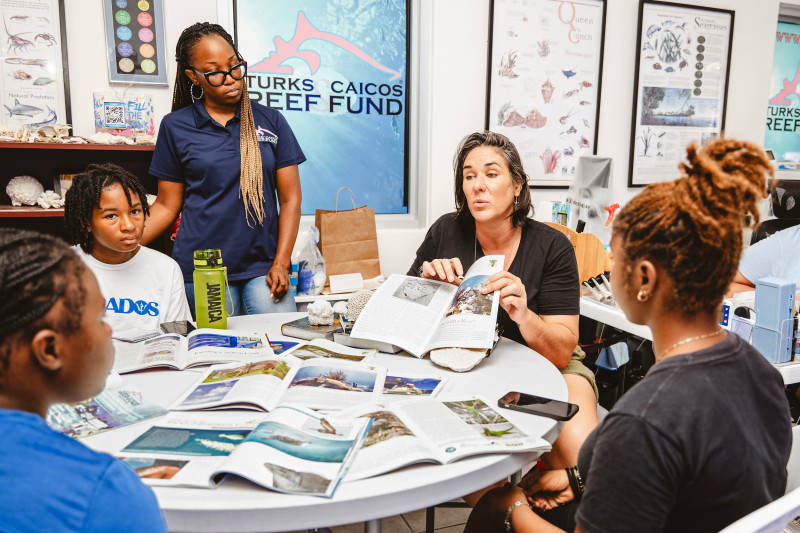
Someday, their offspring will help rebuild the reefs of the future, even if that’s decades from now.
“We’re looking at a hundred, two hundred years,” Zimmermann said. “Until, as a planet, we get a hold of carbon emissions and our temperatures right now, we don’t want these to go back,” she told the visiting high school students, her booming voice echoing the gravity of the situation throughout the lab as the students took turns between gazing at the live coral in the tanks and the shelf of coral skeletons Zimmermann collected with the permission of the government. All of the corals had died from disease. “I thought it was important to archive them,” she said.
Jobs of the Future
In the future, Zimmermann would like to expand the lab, she said, her forearm resting on a table showing off a new tattoo of fine line illustrations of a pillar coral, cactus coral polyp and a maze coral fragment surrounding a double-stranded DNA helix. It’s a reminder, she said, of her future hopes of pursuing a Ph.D. to study coral DNA and genetic interconnectivity between countries throughout the Caribbean region.
She’s currently looking for funding and property to open up a larger facility where local marine scientists can work together with researchers from around the world and learn from one another. “These are the jobs of the future,” she told the visiting students.
She also wants to be able to house more corals. The biobank was at near capacity. She had just enough space for what would be her “last inmate” for a while, she said.
One recent Friday morning, just after sunrise, Zimmerman donned her black and white boulder brain coral printed swim leggings, grabbed her freediving fins, mask and snorkel and waded into shallow turquoise waters off the North shore of Providenciales.
Weeks earlier she was snorkeling in this spot when she spotted a young pillar coral growing on a metal groin meant to prevent beach erosion. Since then she’d returned to check on it several times and remove algae threatening to smother it. Recently, she decided the coral’s best chances for survival would be on land. Pillar corals are functionally extinct.
Through her snorkel mask she spotted the pillar coral, its carpet like tentacles flowing in the surge. She used her fins to hover in place as she pulled out metal snippers from her legging’s pocket. Slowly, she began detaching chunks of the coral from its hold on the groin, cautiously cradling each piece in the palm of one of her hands. The pieces were smaller than she would have liked, she said, but they would fuse back together over time in the lab. When she collected as many of the coral polyps as she could, she popped her head out of the water and took a breath. “Now,” she said, “To the shore!”
About This Story
Perhaps you noticed: This story, like all the news we publish, is free to read. That’s because Inside Climate News is a 501c3 nonprofit organization. We do not charge a subscription fee, lock our news behind a paywall, or clutter our website with ads. We make our news on climate and the environment freely available to you and anyone who wants it.
That’s not all. We also share our news for free with scores of other media organizations around the country. Many of them can’t afford to do environmental journalism of their own. We’ve built bureaus from coast to coast to report local stories, collaborate with local newsrooms and co-publish articles so that this vital work is shared as widely as possible.
Two of us launched ICN in 2007. Six years later we earned a Pulitzer Prize for National Reporting, and now we run the oldest and largest dedicated climate newsroom in the nation. We tell the story in all its complexity. We hold polluters accountable. We expose environmental injustice. We debunk misinformation. We scrutinize solutions and inspire action.
Donations from readers like you fund every aspect of what we do. If you don’t already, will you support our ongoing work, our reporting on the biggest crisis facing our planet, and help us reach even more readers in more places?
Please take a moment to make a tax-deductible donation. Every one of them makes a difference.
Thank you,
David Sassoon
Founder and Publisher
Vernon Loeb
Executive Editor
Share this article
- Republish
Disclaimer: The copyright of this article belongs to the original author. Reposting this article is solely for the purpose of information dissemination and does not constitute any investment advice. If there is any infringement, please contact us immediately. We will make corrections or deletions as necessary. Thank you.

